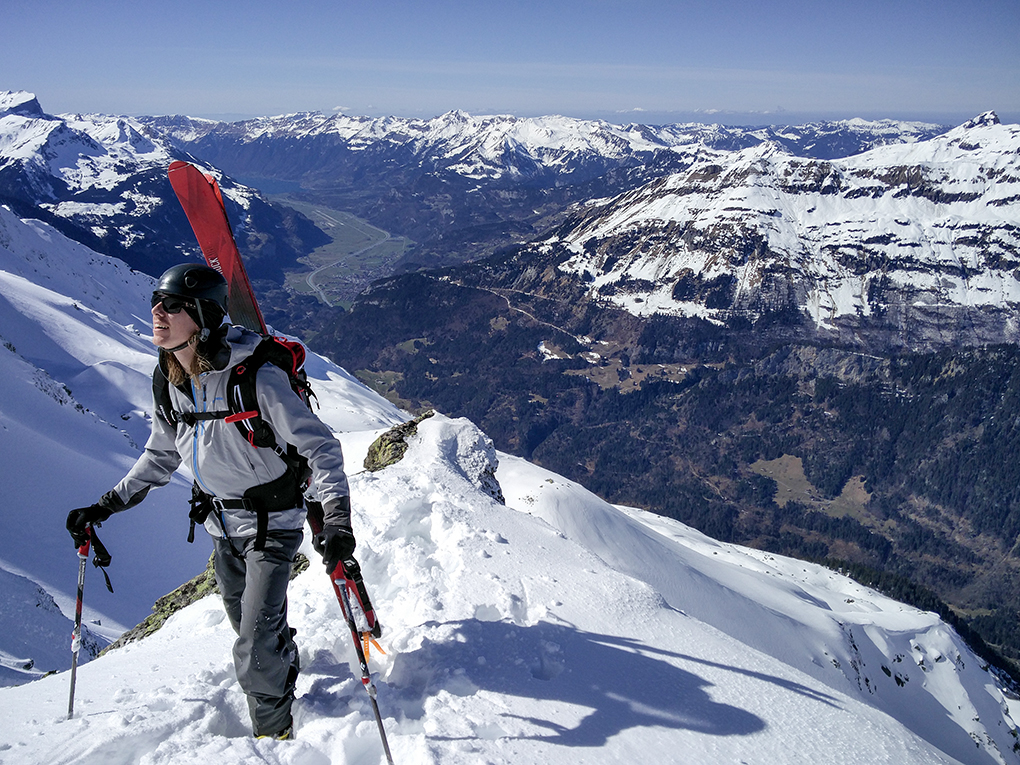
Patagonia Levitation Hoody
Size: M
Stated Weight: 459 g (16.2 oz)
Price: $179 USD
Stated Features:
- Polyester double-weave softshell with a DWR coating
- Breathable and water repellent
- Helmet-compatible hood with visor and one-hand adjustment
- Variable Conditions Cuff
- No-bunch hem drawcord
- Microfleece back-of-neck lining
MSRP: $179
Reviewer: 5’10”, 135 lbs
Days Tested: 10
Test Locations: Chamonix, Berner Oberland, Valais
Intro
The Levitation Hoody by Patagonia was designed for “high-output ice and mixed climbs.” But it has a number of features that made it look like it it could be an ideal on-all-day ski-mountaineering shell, too. Why?
The premise of a spring ski mountaineering shell is tricky—it needs to be highly breathable and packable, while still blocking a decent amount of wind. It doesn’t need to fend off terrible conditions very often, because you try not to go for big objectives in variable weather.

I’ve used many types of shells for ski mountaineering, all of which are “harder” than the Levitation Hoody. My old go-to was the Arc’teryx Beta FL, a minimalist 3-season piece made with Gore Active.
Then I shifted to a few different Polartec NeoShell pieces, but they couldn’t hold a candle to the Patagonia Knifeblade, which is a Polartec Power Shield Pro piece. And the Knifeblade was my favorite ski mountaineering piece for a long while.
The pattern here is that each iteration is similarly minimalistic, but more breathable than the last. I desperately wanted a “shell” that could keep up on the breathability front during high-output ascents, while still repelling spindrift and the occasional rain or snow squall. I don’t like to constantly put layers on and off.
So how does the Levitation Hoody stack up?
Fabric
Patagonia says this of the fabric on the Levitation: “Lightweight, double-weave soft-shell fabric resists abrasion, wind and weather while maintaining great stretch and breathability for highly aerobic activity.”
And on the whole, that is pretty accurate. The fabric is relatively light—the size Medium comes in at about 16 oz (though there are many other true hardshells that come out much lighter).

The face fabric is quite soft to the touch and quiet to wear, yet it shows almost no sign of wear after a few solid weeks of ski mountaineering in the Alps (though it does wrinkle quite easily).
The Levitation stretches quite well. In fact, it is probably the most comfortable shell I’ve ever worn due to the fit, the stretch, and the “Variable Conditions Cuffs,” which I’ll touch on later.
Fit
I really appreciate that Patagonia gave this piece a real mountaineering fit. The sleeves are the perfect length—a touch longer than the sleeves on the Knifeblade but a bit shorter than the sleeves on the Mountain Equipment Centurion. The Levitation’s sleeves hit my hand just below the knuckles.
The body has the perfect amount of room for layering underneath without turning into a baggy sack of fabric when I cinch down my pack’s hip belt. The length is just about perfect, the hood fits over a helmet but can be quickly cinched to accommodate a bare head, and the collar fits well around my chin when zipped up.
My only remark is that for my body type (slimmer than most) I could do with just a slightly slimmer silhouette all around. But for the vast majority of climbers and mountaineers, this fit will be excellent.
Good job, Patagonia.
NEXT: Features, Breathability, Etc.

I see you are saying that it’s not very wind resistant. How would this compare to a wind shirt, microfiber.
I use an arcteryx or a Patagonia houdini.
Hey Rod,
Though I’ve never personally used the Houdini, I have a few friends who swear by it. The Levitation and Houdini are completely different pieces, but purely from a wind blocking perspective, the Houdini (and other similar pieces) should block much more wind than the Levitation.
Hope that answers your question!
Sam